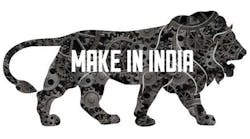Modi's $222 Billion Make-in-India Haul Masks Hurdles to Come
Indian Prime Minister Narendra Modi’s glitzy campaign this week to showcase India as the world’s next manufacturing hub met with a few unpleasant realities of life in Mumbai: a fire engulfed one of the event stages and a strike by rickshaw drivers paralyzed traffic in the financial hub.
More worrying is the conflicting data and vague timelines that raise questions about Modi’s “Make in India” drive, which on Saturday he called “the biggest brand created in India.” The tally for investment pledges soared on the final day to 15.2 trillion rupees, or about $222 billion — more than triple what India has attracted through foreign direct investment since Modi came to office in May 2014.
Whether any of that will materialize remains to be seen. Right now the campaign launched in 2014 is best known for its logo — a lion made of cogs — that has shown up on billboards from Hannover to San Francisco.
“It hasn’t really taken off,” Radhicka Kapoor, a fellow at the Indian Council for Research on International Economic Relations, said of the campaign. “It’ll take a lot more than a flashy new website, a new lion symbol, and catchy phrases to make India a manufacturing powerhouse and create productive jobs for its rapidly rising workforce.”
Modi is pushing to lure manufacturers that can create millions of jobs, allowing India to take advantage of a demographic dividend as its population surpasses China in the next decade. While India’s 1.3 billion people and high growth rate make it a stand-out among emerging markets, other indicators are grim: Investment remains weak, exports have fallen for 14 straight months, borrowing costs are relatively high and trade deals have stalled.
Modi’s efforts to make it easier to operate in Asia’s third-biggest economy have yet to show up in key external indicators. In the World Bank’s Doing Business index, for instance, India still ranks 130 of 189 economies — well short of Modi’s goal to crack the top 50 in two years.
One of the problems of Make in India, Kapoor said, is that it fails to address the outsized influence of states — many governed by Modi’s opponents — on regulatory environments. Unions have opposed changes to some of the world’s most rigid labor laws, and a fractious parliament has blocked a goods-and- services tax that would create a single market in India for the first time.
“India is a difficult place to govern, and one needs to have patience,” said Nilmadhab Mohanty, a former civil servant and honorary senior fellow at the Institute for Studies in Industrial Development in Delhi. “But we don’t have much time — other countries are competing for this and investors will go elsewhere.”
Some relief for manufacturers may be coming in Modi’s budget on Feb. 29. Reports say the government is considering a range of tax incentives to allow exporters to add more workers, particularly in labor-intensive industries like leather, gems and jewelry.
“Under the pressure of this campaign, the government machinery will be required to make a number of corrections on the policy front,” Modi said in the speech on Saturday, speaking to an audience that included his Swedish and Finnish counterparts. “We are committed to make India an easy place to do business.”
Since Modi took office in 2014, foreign direct investment has increased 33% to $64 billion from the previous 20-month period, according to data from the central bank. Yet that mostly went into an e-commerce sector that heavily imports consumer electronics, while job-intensive sectors like construction and energy have either seen declining investments or muted flows, according to Emkay Global Financial Services Ltd.
“The headline numbers gloss over the message emanating from the details,” the brokerage said in an October report.
The event this week elicited 15.2 trillion rupees in investment pledges, Amitabh Kant, secretary of the Department of Industrial Policy and Promotion, told reporters in Mumbai. At least 80% of those are expected to lead to actual investments within three years, he said.
Added to promises Modi has drummed up from foreign leaders, total investment pledges come to at least $421 billion since he took power — more than what has come in during the past 14 years for which data is available.
There’s reason to be skeptical that India will see the money. About 8% of nearly 40 trillion rupees proposed at investment summits during Modi’s 11-year tenure as Gujarat chief minister was actually implemented, according to data from the state’s Directorate of Economics and Statistics.
Modi, for one, knows the pressure is on to deliver: “There is no time for incremental changes,” he said last week. “We want a quantum jump.”
By Natalie Obiko Pearson, with assistance from Jeanette Rodrigues, Adi Narayan, Shruti Srivastava, Rajhkumar K Shaaw, Vrishti Beniwal and Dhwani Pandya




